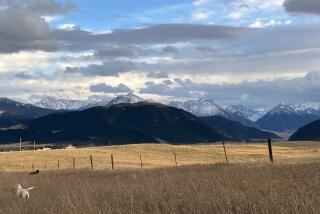From the Archives: When Rhyolite, Nev., had seven residents
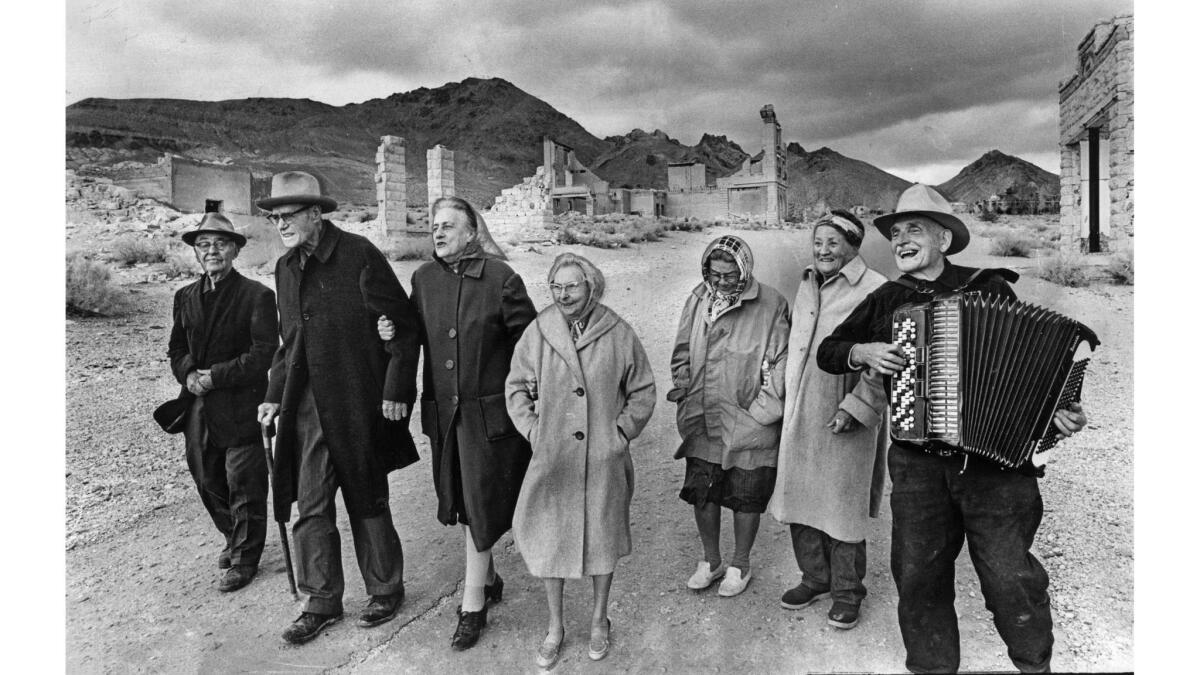
- Share via
From the left in the above photo is “Gasoline” Billy Kleer, 84; the Rev. Herschel Heisler, 80; Frederica Heisler, in her 70s; Bessie Moffat, 88; Louise Morrison, 77, Mary Thompson, 70, the town youngster; and her husband Tommy Thompson, 82, playing accordion.
This photo accompanied a Charles Hillinger story in the Feb. 12, 1969, Los Angeles Times:
RHYOLITE, Nev.–Led by an 82-year-old accordion player, the entire population of this crumbling town–all seven of them–strolled down their dusty street of memories.
Looming behind them, above the ruins of Rhyolite, were the purple Bullfrog Hills, scarred with the diggings of 10,000 men who made the town a roaring camp at the turn of the century.
“This place gave up the ghost long ago. We’re hangin’ on like a bunch of sentimental old fools,” declared “Gasoline” Billy Kleer, who turned out with his friends to welcome a rare visitor to this lonely, windswept town.
Kleer, 84, came by his name when he arrived at the gold camp driving one of the first automobiles in Nevada.
“We’re seven old ghosts haunting a haunted old place,” admitted Mrs. Frederica Heisler, who admits to being in her mid 70s.
The town’s youngster, retired snake charmer Mary Thompson, 70, marched along singing “Under Nevada Skies” to the accompaniment of her husband, Tommy, 82, who was playing one of his 12 accordions.
The other residents of the ghost town are Louise Morrison, 77, a Piute Indian; the Rev. Herschel Herchel Heisler 80, and Bessie Moffat, 88, Rhyolite’s senior citizen.
Rhyolite’s days of glory dawned with a gold strike in 1905.
Citizens of the era predicted that the town would be the “Great Metropolis of the Southwest” or the “Chicago of the West” as buildings of concrete, brick and stone went up instead of familiar mining town shanties.
But Rhyolite, named after a granite-like rock found in the area, didn’t last a century. It was dead in six years.
“Honey, it was the richest, least worked of all the mining camps of the Old West,” said Mrs. Heisler. “It had 42 streets, 400 electric light poles, a $50,000 water works, an opera house, 10 hotels, three banks, five churches and 48 saloons.
“And it had one of the finest railroad depots on earth. The Dearborn Street Station of the West served by the Las Vegas & Tonopah Railroad.”
Mrs. Heisler and her husband, a retired Methodist minister, have a great affection for the depot now standing stark and strange without tracks on a bluff overlooking a vast expanse of Death Valley.
It is their home.
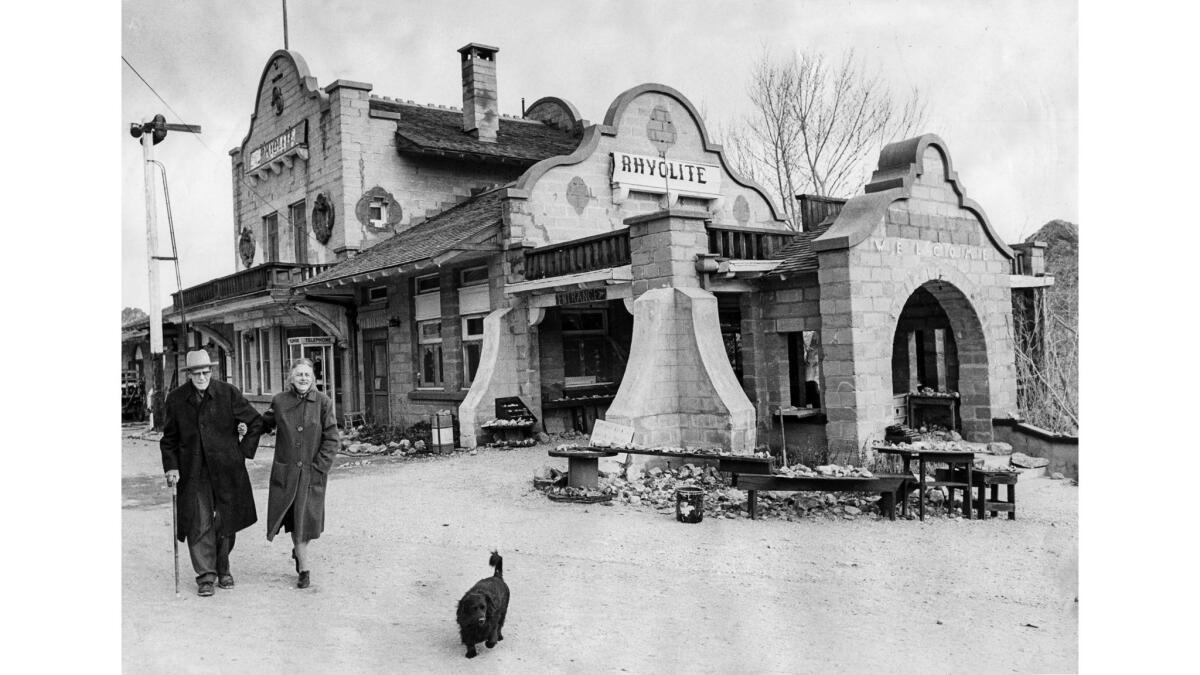
“Time has passed by–the town and the bunch of us here,” said Tommy Thompson. “But we don’t mind.”
Thompson traveled from one mining camp to the next in the old days playing his accordion. He and his wife live in another town landmark, the old Rhyolite Bottle House.
“Saloon keeper Tom Kelly collected 30,000 bottles from behind the town’s 48 bars and built the world’s original bottle house,” said Thompson who has created a miniature Rhyolite in glass in his backyard.
Among yellowed newspaper clippings in the Bottle House are many describing Mary’s heyday as a snake charmer.
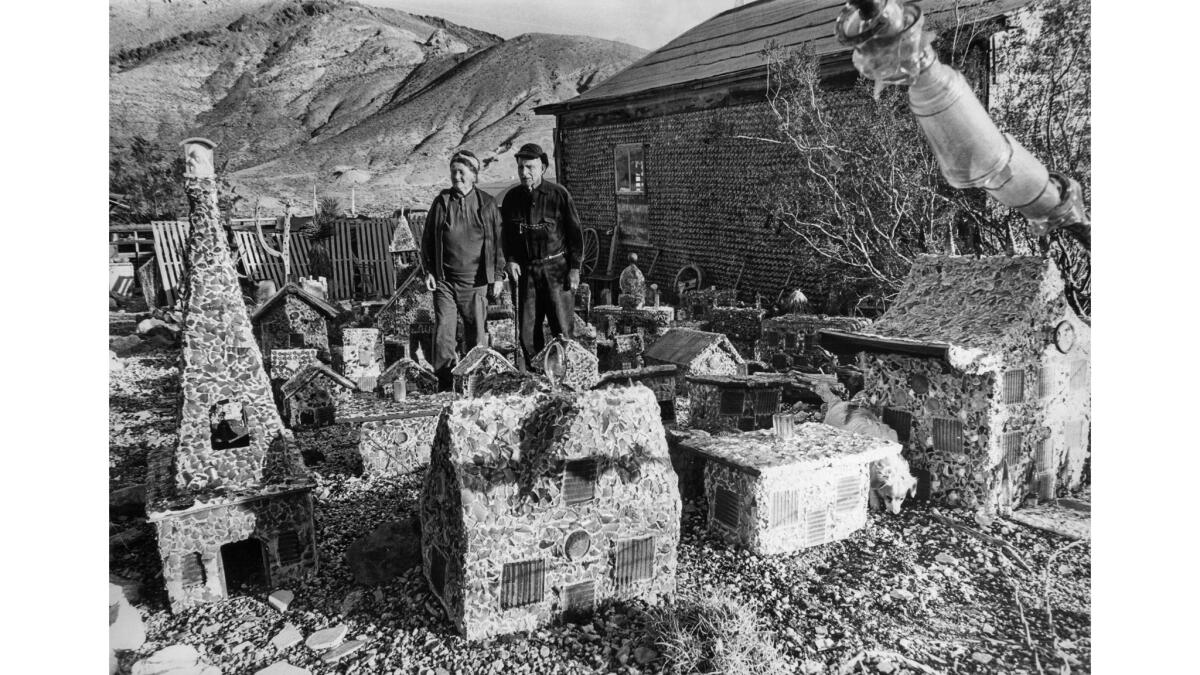
Louise Morrison, a widow, has lived in the town continuously longer than any of the others–since the early 20s.
“Gasoline Billy” is the town bachelor.
“I was just a kid–fresh from a farm in Algon, Iowa, looking for my fortune in these hills,” he said. “I had a two-cylinder Buick.
“When Rhyolite died, I moved on with the rest of the miners–but came back here to retire years ago.”
Kleer owns five acres of Rhyolite with Louise Morrison.
“I don’t know how long I can hang onto it,” he said. “It’s the taxes–too damn high lately. Last year my taxes were $14!”
Mrs. Moffat has lived in Rhyolite since 1933. Her late husband, the town author, James R. Moffat, died last year at age 82.
Moffat was one of the original miners. He wrote a booklet titled “Memoirs of an Old-Timer,” which Bessie sells for $1 in her rock shop.
Sometimes when people drive to Rhyolite on the dirt road that branches off the Beatty-to-Death Valley highway, they think the town is deserted.
They can’t find a sign of the seven old timers.
“That’s because we hide out from time to time,” explains “Gasoline Billy.” “We were hounded with people comin’ in here to our old ghost town.”
In a follow-up article in 1991, Hillinger reported that “Rhyolite has only one year-round resident.” Hillinger reported that Louise Morrison had passed away in 1976, but had no information on the other six residents.
Below, are three additional images of Rhyolite from the Los Angeles Times archives.
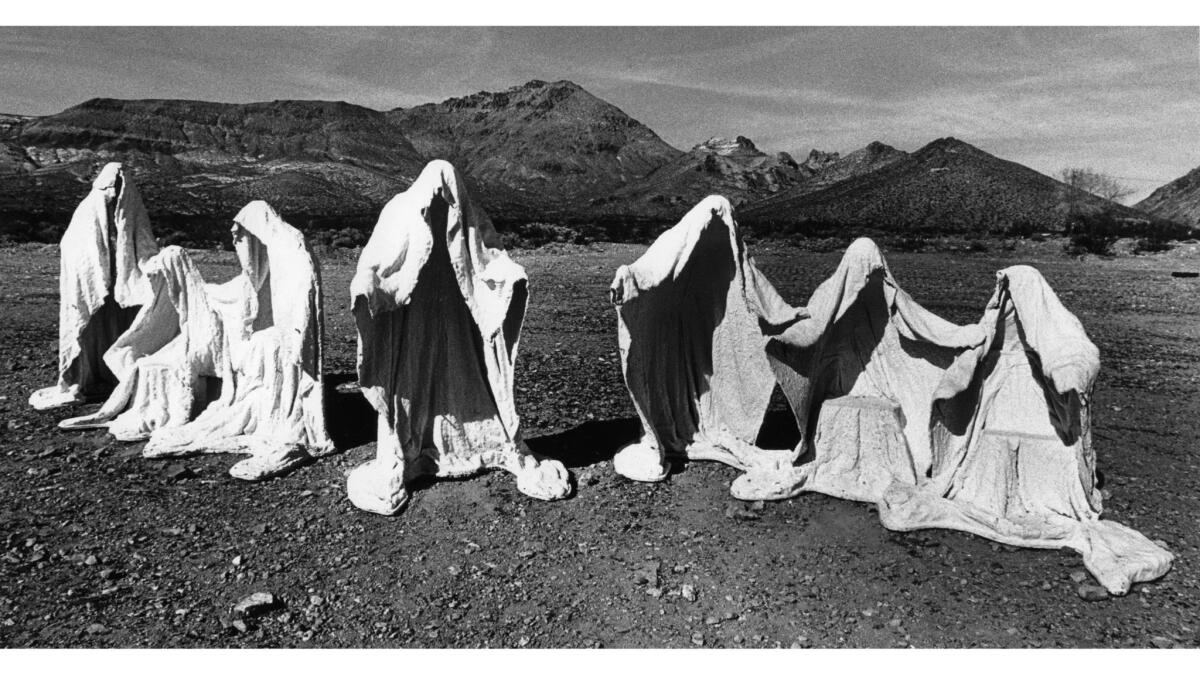
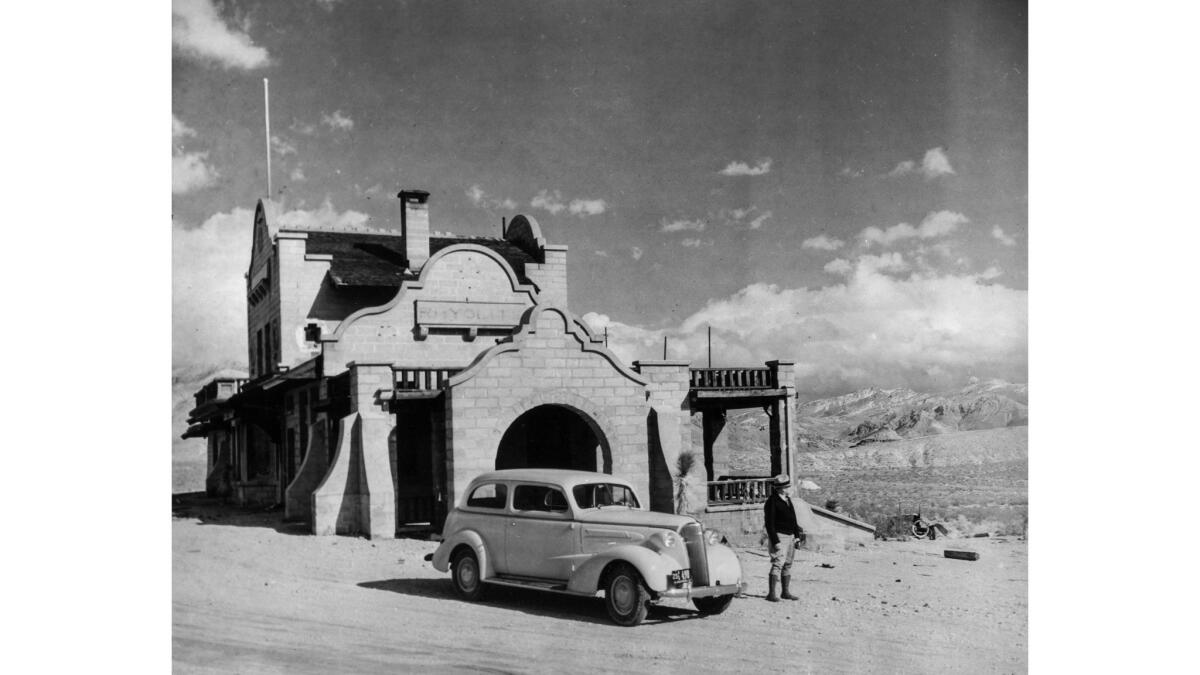
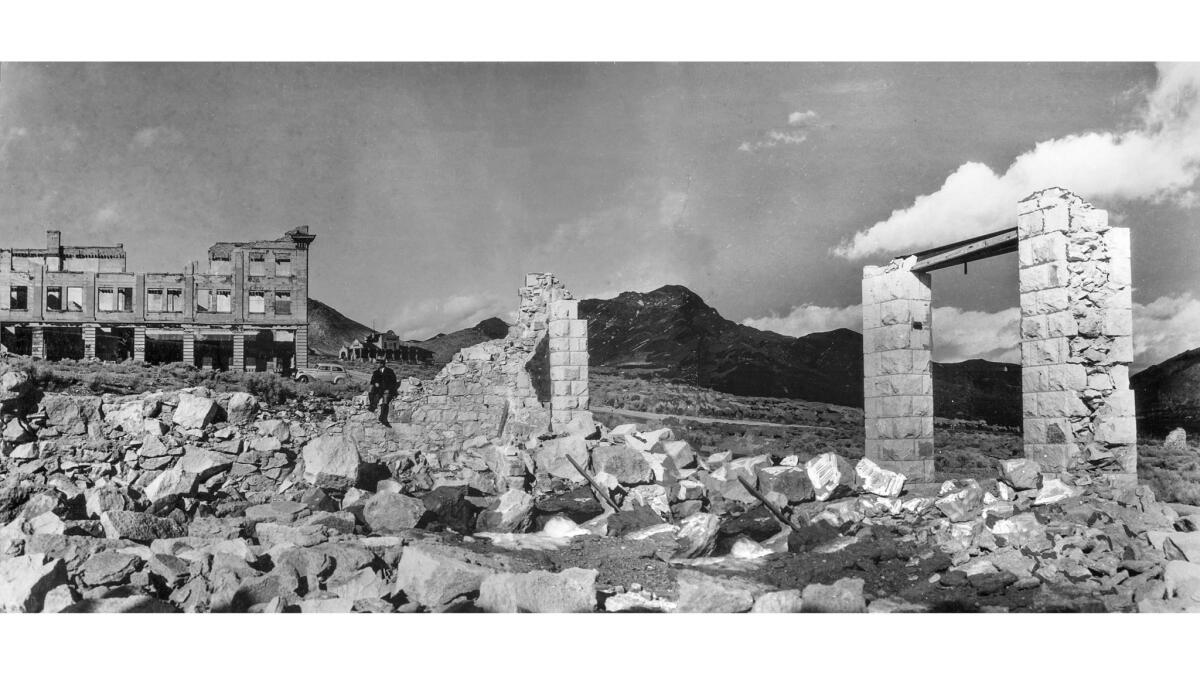
See more from the Los Angeles Times archives here
More to Read
Sign up for Essential California
The most important California stories and recommendations in your inbox every morning.
You may occasionally receive promotional content from the Los Angeles Times.


